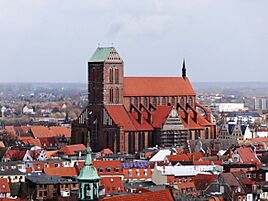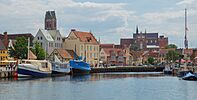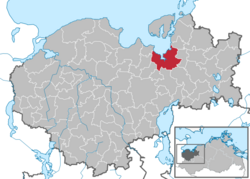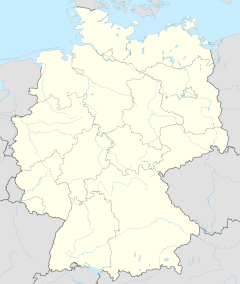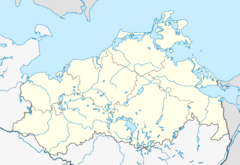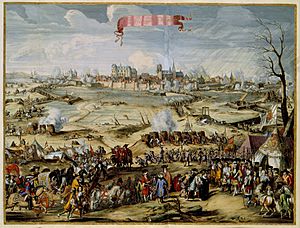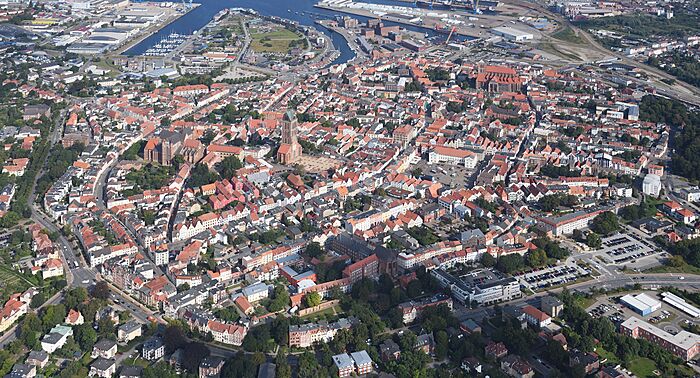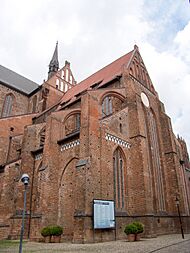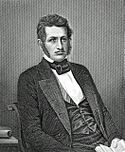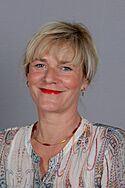Wismar facts for kids
Quick facts for kids
Wismar
Wismer (Low German)
|
|||
|---|---|---|---|
|
St Nicholas' Church
St George's Church
Market Square
Gewölbe
Mühlengrube
Old Harbour
St Mary's Church
|
|||
|
|||
| Country | Germany | ||
| State | Mecklenburg-Vorpommern | ||
| District | Nordwestmecklenburg | ||
| Area | |||
| • Total | 41.72 km2 (16.11 sq mi) | ||
| Elevation | 15 m (49 ft) | ||
| Population
(2022-12-31)
|
|||
| • Total | 43,878 | ||
| • Density | 1,051.73/km2 (2,724.0/sq mi) | ||
| Time zone | UTC+01:00 (CET) | ||
| • Summer (DST) | UTC+02:00 (CEST) | ||
| Postal codes |
23952, 23966, 23968, 23970
|
||
| Dialling codes | 03841 | ||
| Vehicle registration | HWI | ||
Wismar is a historic city in northeastern Germany. It's known as the Hanseatic City of Wismar. About 43,000 people live there, making it one of the largest cities in the state of Mecklenburg-Vorpommern. Wismar is also an important port city on the Baltic Sea.
The city sits on the Bay of Wismar, right across from Poel Island. It's located between the bigger port cities of Lübeck to the west and Rostock to the east. The state capital, Schwerin, is to the south. Wismar is the main city of the Northwestern Mecklenburg district. Its natural harbor is protected by a piece of land sticking out into the sea.
Wismar was likely founded around 1226. In 1259, it became part of the Hanseatic League. This was a powerful group of trading cities. Over time, Wismar was controlled by different German states and even the Swedish Empire. It was part of Sweden from 1648 until 1803. This Swedish history is celebrated every year with a "Sweden Celebration."
Wismar is famous for its Brick Gothic buildings. These are old buildings made of red brick. Many of its historic houses have unique gabled roofs. In 2002, Wismar's old town was named a UNESCO World Heritage Site. It shares this honor with the nearby city of Stralsund. The city is also home to Hochschule Wismar, a university for technology, business, and design. Wismar has a large shipyard, MV Werften Wismar, which builds cruise ships. Three tall churches, St. George's, St. Nicholas', and St. Mary's (only its tower remains), stand out in the city's skyline.
Contents
A Look at Wismar's Past
The name Wismar first appeared in records in the 12th century. Its exact founding date isn't clear. However, a document from 1229 shows that Wismar already had its city rights. In 1301, the city came under the rule of the House of Mecklenburg.
In 1259, Wismar joined a defense agreement with Lübeck and Rostock. This helped protect them from pirates in the Baltic Sea. More cities soon joined this group, which became the Hanseatic League. This league helped organize trade and business. By the 13th and 14th centuries, Wismar was a busy trading center. It was also important for making wool products. Even after a plague in 1376, the city remained successful until the 16th century.
Wismar Under Swedish Rule
| UNESCO World Heritage Site | |
|---|---|

Alter Schwede, built around 1380
|
|
| Part of | Historic Centres of Stralsund and Wismar |
| Criteria | Cultural: ii, iv |
| Inscription | 2002 (26th Session) |
| Area | 88 ha |
| Buffer zone | 108 ha |
After a big war, the Peace of Westphalia in 1648 gave Wismar to Sweden. This meant the Kings of Sweden gained a seat in the German Imperial Diet. Wismar became an important center for all Swedish lands in the Holy Roman Empire. Its defenses were made stronger by Field Marshal Erik Dahlbergh. You can still see parts of these old walls today. In 1675, Danish forces attacked and captured the town.
In 1803, Sweden gave Wismar to the Grand Duchy of Mecklenburg-Schwerin. However, Sweden kept the right to buy it back after 100 years. Because of this, Wismar didn't fully join Mecklenburg-Schwerin until 1897. In 1903, Sweden finally gave up its claim to the city. Wismar still has some special rights from its past, like flying its own flag.
Wismar in the 20th Century
By the late 1800s, Wismar was making iron, steel, paper, and machines. Its harbor was busy with international trade. Ships brought in coal, timber, and iron. They took out grains, oil-seeds, and butter. Wismar also built railroad cars. In 1933, the aircraft company Dornier opened a factory there. In 1881, Rudolph Karstadt opened his first department store in Wismar. This store grew into the famous Karstadt chain.
During World War II, Wismar was badly damaged by bombs. On May 2, 1945, British troops captured the city. A few days later, British Field Marshal Bernard Montgomery met Soviet Marshal Konstantin Rokossovsky in Wismar. After the war, Wismar became part of the Soviet Occupation Zone of Germany.
From 1949 to 1990, Wismar was in East Germany. It became East Germany's second-largest port, after Rostock. The city also developed a big shipbuilding industry. After Germany reunited in 1990, Wismar worked to restore its historic buildings. In 2002, its old town became a UNESCO World Heritage Site. In 2011, Wismar became the capital of the Nordwestmecklenburg district.
City Leaders
Here are some of the people who have served as mayor of Wismar:
- 1919–1929: Hans Rasp
- 1929–1933: Heinrich Brechling
- 1933–1945: Alfred Pleuger
- May 1945–June 1945: Heinrich von Biel
- June 1945–August 1945: Heinz Adolf Janert
- August 1945–1945: Karl Keuscher
- September 1945–1945: August Wilke
- December 1945–December 1950: Herbert Säverin
- January 1951–June 1952: Erhard Holweger
- August 1953–June 1957: Herbert Kolm
- July 1957–April 1969: Herbert Fiegert
- April 1969–November 1989: Günter Lunow
- November 1989–May 1990: Wolfram Flemming (temporary)
- 1990–2010: Rosemarie Wilcken
- Since July 2010: Thomas Beyer
Amazing Sights and Buildings
Wismar's historic old town is built around a huge marketplace. This market square is one of the biggest in northern Germany. It covers about 10,000 square meters. The area is full of old town houses and trading buildings. These were built in the Brick Gothic style between the 13th and 15th centuries. You can also see 19th-century Romanesque Revival architecture and Art Nouveau houses. Buildings from the Swedish period (17th and 18th centuries) also add to the city's unique look.
The main feature of the market square is the Wasserkunst. This is a fancy iron fountain brought from Holland in 1602. On the north side of the square is the Town Hall, built in a Neoclassical style from 1817 to 1819. Another famous building is the Alter Schwede (Old Swede). This is an old brick house built around 1380.
St. George's Church is the third church built on its site. It dates back to 1404. It survived most of World War II. But it was badly damaged by bombs in April 1945, just before the war ended. After Germany reunited, the church was rebuilt. This project cost about 40 million Euros and finished in 2010.
Only the 80-meter-high tower of St. Mary's Church (Marienkirche) remains today. The original church was built in the early 13th century. It was heavily damaged in World War II and partly torn down in 1960.
St. Mary's Church and St. Nicholas (Nikolaikirche) are great examples of Brick Gothic architecture. St. Nicholas' Church, built from 1381 to 1460, has very high ceilings. These churches show the influence of Lübeck's St. Mary's Churches on the whole region.
The Fürstenhof is a beautifully decorated building in the early Italian Renaissance style. It used to be a duke's home. Later, it became the seat of the city government. It was built from 1552 to 1565 and restored in the late 1800s. The Fine Arts Municipal Gallery Baumhaus is located in the old harbor area.
Learning and Education
- Hochschule Wismar – University of Technology, Business and Design
Economy and Industry
Nordic Yards Wismar is a shipbuilding company in Wismar. Shipbuilding has been an important industry in the city since 1946.
Famous People from Wismar
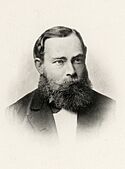
Many interesting people have come from Wismar:
- Klaus Störtebeker (c. 1360–1401), a famous privateer (a type of sailor who attacked enemy ships).
- Sophie of Mecklenburg-Güstrow (1557–1631), who became a queen of Denmark and Norway.
- Friedrich Christoph Dahlmann (1785–1860), a historian and statesman.
- Gottlob Frege (1848–1925), a very important mathematician and philosopher.
- Marita Koch (born 1957), an Olympic champion in track and field.
- Simone Oldenburg (born 1969), a politician who became Deputy Minister-President in 2021.
Wismar in Movies
Wismar has been a setting for movies!
- The 1922 silent horror film Nosferatu, eine Symphonie des Grauens was partly filmed in Wismar. This German Expressionist movie, directed by F. W. Murnau, used Wismar as the fictional town of "Wisborg." Shots from the Marienkirche tower and the harbor area were used.
- Werner Herzog's 1979 remake, Nosferatu, Phantom der Nacht, was also set in Wismar. However, the filming actually took place in the Netherlands.
Friendship Cities
Wismar has special friendships with other cities around the world. These are called twin towns or sister cities:
 Kemi, Finland (since 1959)
Kemi, Finland (since 1959) Aalborg, Denmark (since 1963)
Aalborg, Denmark (since 1963) Calais, France (since 1971)
Calais, France (since 1971) Lübeck, Germany (since 1987)
Lübeck, Germany (since 1987) Kalmar, Sweden (since 2002)
Kalmar, Sweden (since 2002) Pogradec, Albania (since 2019)
Pogradec, Albania (since 2019)
Wismar also has a friendship with Halden in Norway since 1991.
Images for kids
See also
 In Spanish: Wismar para niños
In Spanish: Wismar para niños


